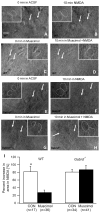Developmental regulation and neuroprotective effects of striatal tonic GABAA currents
- PMID: 20206233
- PMCID: PMC2907073
- DOI: 10.1016/j.neuroscience.2010.02.048
Developmental regulation and neuroprotective effects of striatal tonic GABAA currents
Abstract
Striatal neurons are known to express GABA(A) receptor subunits that underlie both phasic and tonic inhibition. Striatal projection neurons, or medium spiny neurons (MSNs), are divided into two classes: MSNs containing the dopamine D1 receptor (D1-MSNs) form the direct pathway to the substantia nigra and facilitate movement while MSNs expressing the dopamine D2 receptor (D2-MSNs) form the pallidal pathway that inhibits movement. Consequently, modulating inhibition in distinct classes of MSNs will differentially impact downstream network activity and motor behavior. Given the powerful role of extrasynaptic inhibition in controlling neuronal excitability, we examined the nature of striatal tonic inhibition and its potential role in preventing excitotoxicity. Consistent with earlier studies in young (P16-P25) mice, tonic GABA currents in D2-MSNs were larger than in D1-MSNs. However, with age (>P30 mice) the tonic GABA currents increased in D1-MSNs but decreased in D2-MSNs. These data demonstrate a developmental switch in the MSN subtype expressing larger tonic GABA currents. Compared to wild-type, MSNs from adult mice lacking the GABA(A)R delta subunit (Gabrd(-/-) mice) had both decreased tonic GABA currents and reduced survival following an in vitro excitotoxic challenge with quinolinic acid. Furthermore, muscimol-induced tonic GABA currents were accompanied by reduced acute swelling of striatal neurons after exposure to NMDA in WT mice but not in Gabrd(-/-) mice. Our data are consistent with a role for tonic inhibition mediated by GABA(A)R delta subunits in neuroprotection against excitotoxic insults in the adult striatum.
Copyright 2010 IBRO. All rights reserved.
Figures





Similar articles
-
Distinct roles of synaptic and extrasynaptic GABAAreceptors in striatal inhibition dynamics.Front Neural Circuits. 2013 Nov 26;7:186. doi: 10.3389/fncir.2013.00186. eCollection 2013. Front Neural Circuits. 2013. PMID: 24324406 Free PMC article.
-
Differential tonic GABA conductances in striatal medium spiny neurons.J Neurosci. 2008 Jan 30;28(5):1185-97. doi: 10.1523/JNEUROSCI.3908-07.2008. J Neurosci. 2008. PMID: 18234896 Free PMC article.
-
Dopamine modulation of GABA tonic conductance in striatal output neurons.J Neurosci. 2009 Apr 22;29(16):5116-26. doi: 10.1523/JNEUROSCI.4737-08.2009. J Neurosci. 2009. PMID: 19386907 Free PMC article.
-
Axonal Modulation of Striatal Dopamine Release by Local γ-Aminobutyric Acid (GABA) Signalling.Cells. 2021 Mar 23;10(3):709. doi: 10.3390/cells10030709. Cells. 2021. PMID: 33806845 Free PMC article. Review.
-
Use of multicomponent reactions in developing small-molecule tools to study GABAA receptor mechanism and function.Future Med Chem. 2011 Feb;3(2):243-50. doi: 10.4155/fmc.10.302. Future Med Chem. 2011. PMID: 21428818 Free PMC article. Review.
Cited by
-
Decrease in tonic inhibition contributes to increase in dentate semilunar granule cell excitability after brain injury.J Neurosci. 2012 Feb 15;32(7):2523-37. doi: 10.1523/JNEUROSCI.4141-11.2012. J Neurosci. 2012. PMID: 22396425 Free PMC article.
-
Pubertal hormones increase hippocampal expression of α4βδ GABAA receptors.Neurosci Lett. 2019 May 14;701:65-70. doi: 10.1016/j.neulet.2019.02.005. Epub 2019 Feb 8. Neurosci Lett. 2019. PMID: 30742936 Free PMC article.
-
Inhibitory collaterals in genetically identified medium spiny neurons in mouse primary corticostriatal cultures.Physiol Rep. 2013 Nov;1(6):e00164. doi: 10.1002/phy2.164. Epub 2013 Nov 24. Physiol Rep. 2013. PMID: 24400165 Free PMC article.
-
An E3-ligase-based method for ablating inhibitory synapses.Nat Methods. 2016 Aug;13(8):673-8. doi: 10.1038/nmeth.3894. Epub 2016 Jun 6. Nat Methods. 2016. PMID: 27271196 Free PMC article.
-
The impact of tonic GABAA receptor-mediated inhibition on neuronal excitability varies across brain region and cell type.Front Neural Circuits. 2014 Feb 3;8:3. doi: 10.3389/fncir.2014.00003. eCollection 2014. Front Neural Circuits. 2014. PMID: 24550784 Free PMC article. Review.
References
-
- Albin RL, Reiner A, Anderson KD, Dure LS, Handelin B, Balfour R, Whetsell WO, Jr, Penney JB, Young AB. Preferential loss of striato-external pallidal projection neurons in presymptomatic Huntington’s disease. Ann Neurol. 1992;31:425–430. - PubMed
-
- Beister A, Kraus P, Kuhn W, Dose M, Weindl A, Gerlach M. The N-methyl-D-aspartate antagonist memantine retards progression of Huntington’s disease. J Neural Transm Suppl. 2004;68:117–122. - PubMed
-
- Bracci E, Panzeri S. Excitatory GABAergic effects in striatal projection neurons. J Neurophysiol. 2006;95:1285–1290. - PubMed
Publication types
MeSH terms
Substances
Grants and funding
LinkOut - more resources
Full Text Sources
Molecular Biology Databases
Research Materials
Miscellaneous

